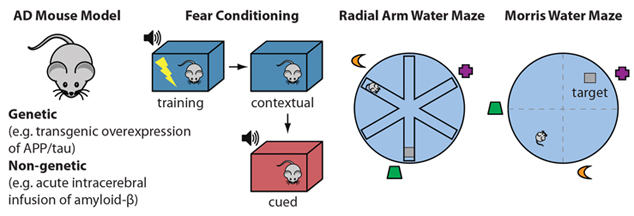Columbia University
Irving Medical Center
Neurological Institute
710 West 168th Street, 3rd floor
(212) 305-1818
TaubCONNECT Research Perspectives:
February 2014
Behavioral Assays with Mouse Models of Alzheimer's Disease: Practical Considerations and Guidelines
Amyloid plaques and neurofibrillary tangles have dominated the debate over the causes of Alzheimer's disease (AD) for many years. However, neither of these histopathological lesions nor the two proteins constituting their major components, amyloid-beta for amyloid plaques and tau for neurofibrillary tangles, has been shown to be the primum movens in the disease. Since cognitive failure is the chief complaint and central symptomatic feature of the disease, basic research and translational studies on AD should avoid assumptions about its etiopathogenesis and instead focus on mitigating the cognitive and behavioral consequences.
In this Biochemical Pharmacology review, together with first author Daniela Puzzo and colleagues, we discuss the basics of available transgenic and non-transgenic AD mouse models and describe in detail three well-established behavioral tasks commonly used for testing hippocampal-dependent cognition in mice - contextual fear conditioning, radial arm water maze, and Morris water maze. Given the central role played by the hippocampus in memory and AD pathology, these rodent cognitive assays that are hippocampus-dependent are ideally-suited for AD research. Among their advantages, are that these tasks can be easily implemented and allow for the relatively quick evaluation of large numbers of mice in a short period of time. We also discuss the practical considerations of these assays – the protocols, guidelines, and caveats based on our experience with various transgenic and non-transgenic AD mouse models.
Moreover, we provide a list of some AD approved drugs and experimental compounds that have given positive results in various behavioral assays performed in our laboratories and might, therefore, be used as positive controls in drug development studies. Finally, we discuss the failure of recent clinical trials with drugs that showed promising efficacy in preclinical behavioral tasks. A limitation of the use of memory tasks in animal models of the disease is linked with the fact that these tasks are incomplete analogs of human cognition. Indeed, many cognitive functions are unique to humans or cannot be adequately measured in experimental models (e.g. working memory related to language or math). Nevertheless, in the absence of practical alternatives, cognitive assays in mouse models of the disease will continue to be essential for investigating AD-type pathology in vivo and testing therapeutic strategies.
Ottavio Arancio, MD, PhD
Oa1@columbia.edu


